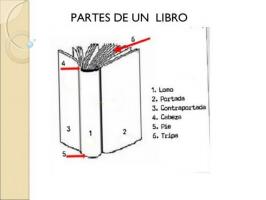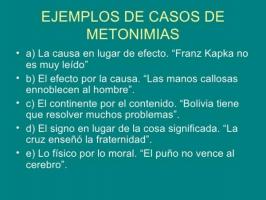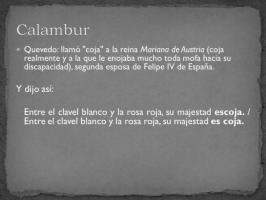Discover the MAIN types of METONYMY in Spanish
For Sara Caro. July 16, 2019
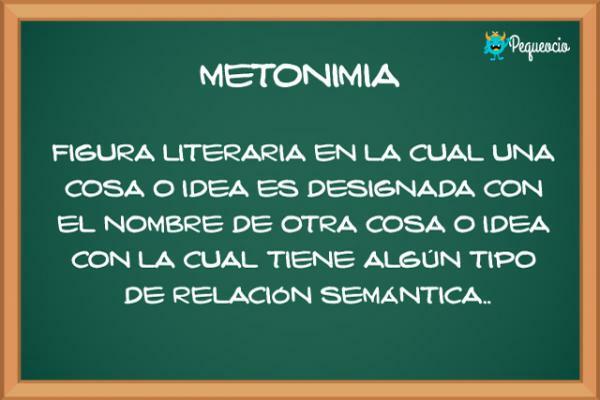
Image: Pequeocio
Have clear definitions of the literary figures and its uses is essential when it comes to analyzing a text. That is why in this lesson from a TEACHER we are going to know the different types of metonomy as well as a clear definition and examples, one of the most used figures of speech. So take a pencil and paper and do not lose detail of the explanation. After reading it, you will not have any doubts about metonymy. Take note!
Before knowing the types of metonymy that exist, it is important to better understand their meaning. In rhetoric, metonymy, also known as transnomination, is a Literary figure that designates something with the name of another thing, taking as the main cause or vice versa and with which a semantic relation of presence, as a substitution mechanism. That is, in metonymy it is common to designate an author by his works, or vice versa.
For example: I have a Dali = I have a picturepainted by Dalí.
In this situation, we substitute the entire phrase for
painting painted by Dalí by, simply, the name of the author to be well known.As a general rule, the spelling in metonymy does not undergo any kind of change. The capital letters of the proper names used as common are preserved, as in the example of Dalí, works of authorship and other names. However, there are some exceptions.
For example: Give me a sherry = give me a original wine from Jerez.
In this case, despite the fact that Jerez is a city, a lexicalization is included that allows the use of the lower case in Jerez wine. A sherry.
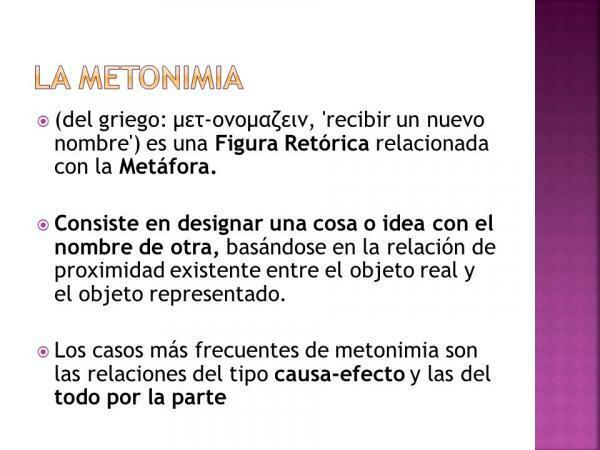
Now that we know what this literary resource is, we are going to discover the different types of metonymy that may exist and it is that, within metonymy, they can attend to different concepts. Let's get to know them.
- Cause by effect: "I lack bread and wine. Here, the substitution refers to the fact that he does not have a job, hence he cannot have bread at home.
- Effect for cause: "Dogs are the joy of our days." Dogs cause happiness every day.
- Continent by content: "He ate two dishes." Subject ate food from two plates.
- Symbols for symbolized things: "The military man swore allegiance to the flag." In this case, the military man swore allegiance to the country that bears that flag.
- Place where it occurs: "Have a Rioja". Here it refers to the wine that comes from La Rioja.
- Trademarks by objects: "Pay with the VISA". That is, you pay with your credit card.
- Author by work: "I'm listening to Bach." A musical composition by Johann Sebastian Bach is heard. Known by his last name.
- Possession of an object: "The first violin of the orchestra". Here it does not refer to the violin, but to the first violinist of the orchestra.
- One part for the whole: "There was not a soul in the store." Refers to no one in the store, not a ghost town
- The whole for one part: "I'm going to wash the car." It means that it will clean the car body, that is, the exterior, not the car engine.
- Matter for object: "Make me a canvas." Here he means that I paint him a picture.
- The name of an object by another close to it: "He adjusted his shirt collar." Being close to the human neck, it is the name by which that part of the shirt is designated.
- An instrument that he uses it for: "He has an impeccable pen." Here he is referring to a very talented writer.
- The physical for the moral: "We lost our minds." It is not referring to someone having lost their mind, but rather their judgment.
In a general analysis it should suffice to indicate what metonymy is. However, knowing what type of metonymy it is will help you identify it more easily.

Image: Examples - Yavendras.com
After knowing the definition and all the types of metonymy we could say that it serves to name someone or something for a substitution that is related to it and that implies objective relations of presence or closeness. It should not be confused with metaphor, since in this the closeness is not objective and much less real as it is a subjective association.
Example of metonymy:
- Buy a port wine = it is so called because it is produced in the city of Porto, in Portugal.
- The collar of the shirt = is called the neck because of the proximity of the human neck.
Examples of metaphor:
Her lips are made of strawberry = in this case we are not saying that her lips are two strawberries, but rather that they have a pink tone that is precisely reminiscent of the color of strawberries.
So that you can understand it much better, we are going to see some examples of metonymy that are very clear and that they are included in different types.
- Reading Agatha Christie makes my hair stand on end. (Here is not a specific work, but the entire work of the author).
- He is a good violin. (Instead of her he is a good violinist).
- He is a man of his word. (That she complies with what she says).
- The age that his skin shows. (Refers to wrinkles).
- In that museum there are several Picasso. (Pictures painted by Picasso).
- Give me your phone and I'll call you. (He means that he gives you his phone number, not the device with which he receives calls).
- He has a furnished head. (It does not mean that he has furniture in his head, but that he is a very sensible person).
- La Zarzuela has already made statements. (It is not the building that makes a statement, but the people who belong to the Royal Household and live in the Zarzuela, which, in this case, is the King of Spain).
- He smoked a pipe. (It refers to the fact that he smoked the contents of a pipe, that is, tobacco).
Don't forget to visit our section Spanish language in a PROFESSOR!
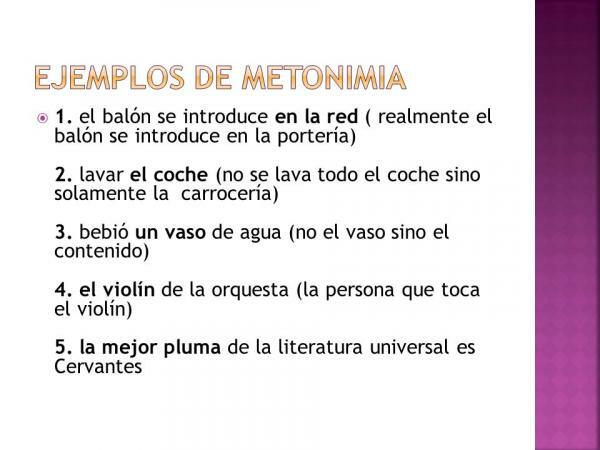
Image: SlidePlayer

